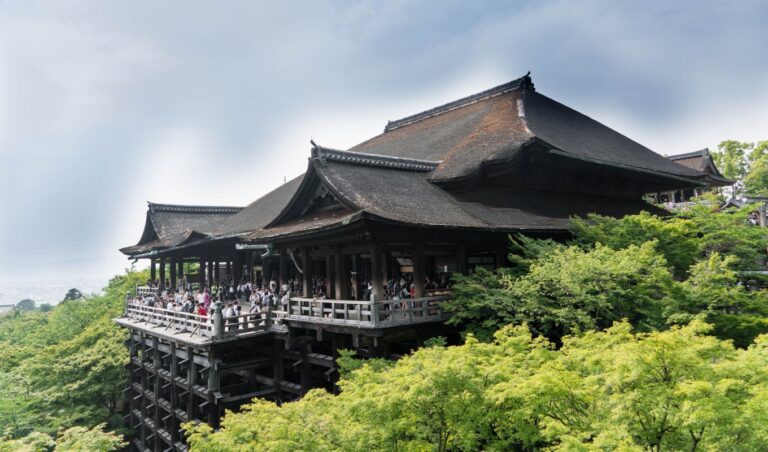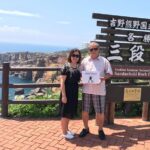Myoshinji Temple is a large temple complex in the northwestern part of Kyoto. The temple complex is known for its dedication to zazen meditation and is considered to be the head temple of the Rinzai Zen branch. The temple complex comprises of about 50 sub-temples in addition to its main buildings.

While some of the temple halls can be entered, the majority of the sub-temples are closed to the public. However, visitors are free to wander along the walking paths which interconnect the sub-temples. The temple complex is spread across a vast area interconnected by stone paths and is a great place to experience Zen solitude, lodging, and meditation in Kyoto.
It is also known for its shukubo, which is a temple lodging experience where you can stay overnight in the temple complex. The shukubo experience lets you to experience the daily life of a Zen monk, including participating in morning meditation, eating vegetarian meals, and sleeping on a traditional Japanese futon.
History
The temple was founded in 1337 by an abdicated emperor who had an imperial villa converted into a Zen temple. The emperor, Hanazono, donated the palace to found the temple.
The temple’s history is closely tied to the imperial family. Emperor Hanazono’s imperial villa was in the Hanazono district, which is named after him. After abdicating the throne, Hanazono became a monk and studied Zen under the guidance of one Shūhō Myōchō. It was under Myōchō’s guidance that Hanazono founded Myoshinji Temple.
Myoshinji Temple has managed to preserve much of its original architecture and design. The temple complex contains 46 sub-temples spread across a vast area interconnected by stone paths.
Despite its historical significance, the temple remains largely unvisited by foreign tourists, making it an ideal destination for those looking to experience the rich history and culture of Kyoto without the crowds.
Architecture

Myoshinji Temple is known for its beautiful Zen-style architecture. Many of the buildings in the precincts of the temple complex are fine examples of traditional Japanese architecture.
The temple was designed with Zen principles in mind, which emphasizes simplicity, harmony, and tranquility. The buildings are characterized by their clean lines, natural materials, and minimalist aesthetic. The use of wood and stone is prevalent throughout the complex, giving it a warm and inviting feel.
The main hall, or hondo, is one of the most impressive structures in the temple. It was built in the early 1600s and features a large, open interior with high ceilings and intricate woodwork. The hondo is also home to a beautiful statue of the Buddha, which is considered to be one of the most important Buddhist statues in Japan.
Another notable building in the temple complex is the Butsuden, or Buddha Hall. This hall is dedicated to the practice of zazen meditation and features a serene, peaceful atmosphere. The Butsuden is also home to several important Buddhist relics and artifacts.
Gardens
One of the most famous gardens at Myoshinji Temple is the Taizo-in garden, which was created by the renowned painter Kano Motonobu. This dry landscape garden features carefully arranged rocks and gravel, and is designed to evoke a feeling of serenity and tranquility.
Another notable garden at Myoshinji Temple is the Shinju-an garden, which features a pond and a small waterfall. The garden is particularly beautiful in the autumn, when the leaves change color and the reflections in the water create a stunning visual effect.
In addition to these larger gardens, there are also many smaller gardens scattered throughout the temple complex. These gardens are often hidden away in quiet corners, and are designed to be discovered and enjoyed by visitors who take the time to explore the temple grounds.
Art and Treasures
The Temple is home to many unique and historic works of art and treasures that are worth seeing. Here’s a few of the highlights:
- The Butsuden (Buddha Hall) contains an image of Sakyamuni, the historical Buddha.
- The Hatto (Lecture Hall) is decorated with a beautiful picture of a dragon attributed to Tan-yu Kano (1602-74).
- Myoshinji also has Japan’s oldest bell, which was cast in 698 and is a National Treasure.
- The temple is also known for its dedication to zazen meditation, which is a form of seated meditation that is practiced in Zen Buddhism.
While some of the temple halls can be entered, the majority of the subtemples are closed to the public. However, visitors are free to wander along the walking paths and admire the beautiful gardens and architecture.
Visiting Myoshinji Temple

The temple complex is in the northwestern part of the city and is easy to get to. You can take the JR Sagano Line to Hanazono Station, which is just a short walk from the temple entrance.
Upon entering the temple grounds, visitors will be greeted by a serene and peaceful atmosphere. The temple complex is quite large, spanning over 100 acres, and includes about 50 sub-temples in addition to its main temple. You can easily spend several hours exploring the grounds and admiring the beautiful architecture and gardens.
One of the most popular activities those to Myoshinji Temple is zazen meditation. The temple is known for its dedication to zazen meditation, and you can participate in a meditation session led by a monk. The meditation sessions are held daily and last about an hour. Visitors should arrive early to secure a spot, as the sessions can fill up quickly.
Another highlight of a visit to Myoshinji Temple is the opportunity to stay overnight in one of the temple’s traditional Japanese-style guest rooms. The rooms are simple, yet comfortable, and offer visitors a unique experience of temple life. Guests are invited to participate in morning meditation and other temple activities, as well as enjoy a vegetarian meal prepared by the temple’s monks.
Overall, a visit to Myoshinji Temple is a must-do for anyone interested in Japanese culture and history. The temple complex offers a peaceful and serene escape from the hustle and bustle of Kyoto, and you can experience firsthand the traditions and practices of Zen Buddhism.




